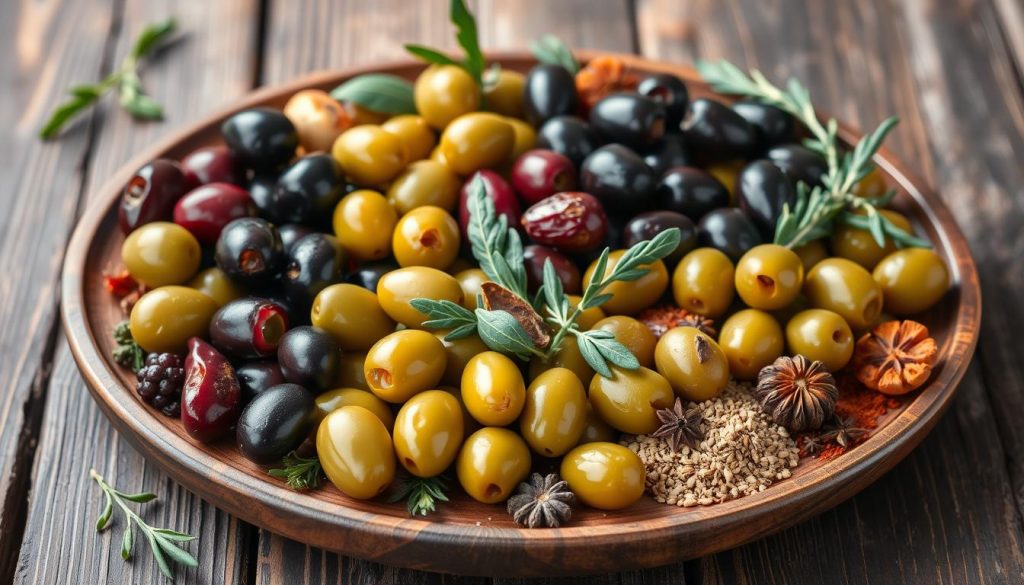Castelvetrano olives are loved for their mild, buttery taste and meaty texture. They come from the Valle del Belice in Sicily, Italy. For over 8,000 years, they’ve been a key part of Sicilian cooking.
When you can’t find Castelvetrano olives, it’s good to know other options. This guide helps you find the right olives for your recipes. You can use them in cheese boards, salads, or pasta dishes.
Introduction to Castelvetrano Olives
Castelvetrano olives are famous for their unique taste and quality. They are grown only in a certain part of Sicily. This makes them special, as they are recognized for their high quality under Protected Designation of Origin.
This protection ensures they are made the traditional way. This means they are both tasty and true to their roots.
What Makes Castelvetrano Olives Unique?
Castelvetrano olives are known for their great taste and texture. They come from Castelvetrano in Sicily and are firm but meaty. Their mild and buttery flavor is loved by many.
Because of their sweetness and tenderness, they are a hit with olive lovers.
Flavor Profile of Castelvetrano Olives
The taste of Castelvetrano olives is complex and inviting. They have a mild sweetness and a hint of nuttiness. This makes them taste balanced and rich.
Unlike bitter olives, they are a delightful way to enjoy Sicilian olive traditions. They add a satisfying taste to any dish.
Uses in Various Dishes
Castelvetrano olives are very versatile. They can be used in:
- Salads, adding flavor and color
- Pasta dishes, improving the sauce’s taste
- Antipasto platters, looking great
- Cocktails, adding a surprise
They pair well with wine and cheese. This makes them a great addition to any dish, offering a fun taste adventure.
| Aspect | Details |
|---|---|
| Origin | Sicily, Italy |
| Flavor | Mildly sweet and buttery |
| Texture | Firm yet meaty |
| Culinary Uses | Salads, pasta, antipasto platters, cocktails |
| Pairings | Wines, cheeses |
Understanding Olive Substitutes
When you’re looking for recipes that use Castelvetrano olives, you might need substitutes. This could be because Castelvetrano olives are hard to find, you have dietary restrictions, or you want to try new flavors. Knowing what makes olives different can help you pick the right ones for your dishes.
Why You Might Need a Substitute
You might need olive substitutes because they’re not available or you want a different taste. For example, if you’re watching your sodium intake or following a certain diet, you might choose other olives. Some people just like to explore different flavors and textures in their cooking.
Common Characteristics to Look For
When looking for a substitute, think about these olive characteristics:
- Flavor: Find olives with a similar buttery or mild taste.
- Texture: Pick olives that are meaty and firm, like Castelvetrano.
- Appearance: Choose olives that are green or similar in color to match your dish.

Castelvetrano Olives Substitute Guide
Finding the right substitute for Castelvetrano olives depends on your recipe and taste goals. When choosing olive substitutes, think about flavor and texture. This will help you get the taste and feel you want in your dish.
Choosing the Right Substitute for Your Recipe
For recipes needing Castelvetrano’s creamy taste, try California Sevillano or Cerignola Green Olives. They have a mild flavor that works well in many dishes.
Comparative Flavor Profiles
Here’s a quick guide to different olive flavors for easy flavor comparison:
| Olive Variety | Flavor Profile | Texture |
|---|---|---|
| Castelvetrano | Mild, Buttery | Firm |
| California Sevillano | Mild, Fruity | Firm |
| Cerignola Green | Buttery, Mild | Soft |
| Manzanilla | Slightly Bitter, Tangy | Small to Medium, Firm |
| Kalamata | Fruity, Rich | Soft, Meaty |
Texture and Maturity Level
The olive texture and maturity level are key in your dish. Young, firm olives are great for salads and platters. Softer olives blend well in sauces or spreads. Think about these when picking a substitute to enhance your dish’s taste and look.

Top Alternatives to Castelvetrano Olives
Looking for the best alternatives to Castelvetrano olives? You’ll find many options, each with its own unique taste and texture. These alternatives can take your cooking to the next level and satisfy your taste buds.
California Sevillano Olives
California Sevillano olives are a tasty choice. They have a buttery flavor and a firm texture, making them great for snacking. Their mild taste works well in many dishes, just like Castelvetrano olives.
Adding Sevillano olives to salads or antipasto plates can add a rich flavor.
Cerignola Green Olives
Cerignola olives are the biggest in the world. They have a slightly sweet and buttery taste. Their crisp texture adds a refreshing touch to dishes.
They’re perfect for pasta or as an appetizer. Cerignola olives are a great substitute for Castelvetrano, adding a mild and pleasant flavor to your meals.
Manzanilla Olives
Manzanilla olives have a distinct briny taste. They’re small and have a rich flavor, making them great for tapas or salads. Choosing Manzanilla olives as a substitute adds a flavorful twist to any recipe.
Calamata Olives
Calamata olives have a bold, tart flavor. Their dark purple skin and almond shape make them beautiful for garnishing dishes. They’re perfect for Mediterranean dishes, keeping your meal authentic even with a substitute.
How to Use Substitutes Effectively
Need alternatives for Castelvetrano olives? Knowing how to use substitutes can make your cooking better. Learning about different cooking methods and how to mix ingredients helps you get the taste you want in your food.
Cooking Techniques That Work
When using substitutes like California Sevillano or Cerignola olives, some cooking methods work best. Sautéing them brings out their unique tastes. Making tapenade is another great way to mix their flavors well.
Using these techniques lets you get the most out of your substitutes. This makes your meals tasty and fulfilling.
Pairing with Other Ingredients
Pairing substitutes with other ingredients is key. Try mixing olives with cheeses for a tasty platter. Olive pairings also work well on charcuterie boards, adding variety in texture and taste.
Mediterranean herbs can make your dishes even better. They highlight the special qualities of each substitute. This way, simple recipes become gourmet delights.
Storing and Preparing Substitute Olives
Proper handling of substitute olives can greatly improve your dishes’ taste and quality. Focus on storing olives effectively to keep them fresh and flavorful. Also, prepare olives for cooking well to boost your recipes.
Best Ways to Store Olives
To keep your olives fresh, follow these tips:
- Refrigerate in brine or lightly salted water to keep olives firm and flavorful.
- Ensure olives are fully submerged to avoid drying out.
- Consume within two months after curing to enjoy optimal taste.
Preparation Tips Before Cooking
Effective preparation is key to maximizing olive flavor in your dishes. Here are some steps to prepare olives for cooking:
- Pit olives before use, for a smoother texture in your recipe.
- Slice or chop olives based on your dish’s requirements to enhance their integration into meals.
- Rinse cured olives to reduce excess saltiness if desired.
Conclusion
Exploring Castelvetrano olive alternatives makes your cooking more exciting. It lets you add new flavors to your dishes while keeping their unique taste. By trying out different substitutes like Gaeta or Nicoise, you can get creative in the kitchen.
Every substitute has its own special taste, from the buttery Castelvetrano olives to the fresh green olives. This lets you try new things without worrying about losing flavor. It’s a great way to learn more about the world of flavors.
Start exploring the world of olives and their substitutes. Try using sun-dried tomatoes or capers to make your meals even better. Your cooking will always be full of flavor and fun, keeping your taste buds happy.
Source Links
- https://www.seriouseats.com/guide-to-olive-varieties
- https://www.delallo.com/blog/castelvetrano-olives/?srsltid=AfmBOoo0BSKM1Iv0PvB0Gem-FmwZtHaYtoqVYl3fj_8VYapMzZb92GZW
- https://solidstarts.com/foods/olives/
- https://kalejunkie.com/warm-marinated-olives/
- https://giadzy.com/blogs/tips/your-guide-to-all-the-italian-olives-and-what-to-do-with-them?srsltid=AfmBOoqXFqH77GNjodVBukWMdWzqe5ZVwn1KohfGdW-gzRHzVh86PE5p
- https://brightland.co/blogs/field-notes/olive-varieties?srsltid=AfmBOor_dRb6Fx6wKc9UYLRBGB77REw5vzrJjQx63GO11kWG3mbN2OvY
- https://www.delallo.com/blog/castelvetrano-olives/?srsltid=AfmBOoq9Qz5FXFdqXMwvYu_ZFZI86ifh_bZ7pC4yUtL2VX0cVubL9S85
- https://giadzy.com/blogs/tips/your-guide-to-all-the-italian-olives-and-what-to-do-with-them?srsltid=AfmBOoocPSeiQzWt76OWQSwT72HmC8prjysn8pORprQcFADeQ3jHbiTc
- https://www.webstaurantstore.com/guide/927/types-of-olives.html?srsltid=AfmBOooLLi9Q73nAzPl29-HTk7t_2VdGX441OgvQbMFv8voFEx0BnLVE
- https://giadzy.com/blogs/tips/your-guide-to-all-the-italian-olives-and-what-to-do-with-them?srsltid=AfmBOorOFI0_5UvfsuNSTXDK87UE_EmrBsIoQYznQsvbcyTdXeagh-I-
- https://www.delallo.com/blog/castelvetrano-olives/?srsltid=AfmBOopwPZAcDfIj1ZFuGo8ZguNIQEt-Oy7n0p9fUE7_Z_8_6A8aPf_y
- https://food52.com/blog/15617-the-best-worst-ways-to-pit-an-olive-without-an-olive-pitter?srsltid=AfmBOopi48cBa-xlzrVwKnge_QA7lPdkvSVkH0KqYXnrYWmaFgpd4cZg
- https://www.epicurious.com/ingredients/different-types-of-olives-how-to-buy-store-cook-recipes-article
- https://punchdrink.com/articles/dirty-martini-olive-brine-alternatives/
- https://www.feastingathome.com/home-cured-olives/
- https://brightland.co/blogs/field-notes/olive-varieties?srsltid=AfmBOoq9SA1sI1G3qMyk722NCOgEZGiOSa1iC7s3QZ6ZX0cEzy2OVH1g
- https://www.beautifulwithplants.com/olive-substitute/
- https://pmc.ncbi.nlm.nih.gov/articles/PMC11417546/
